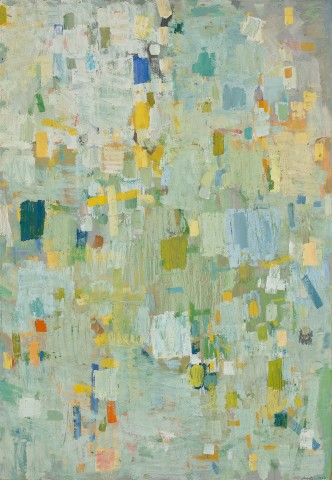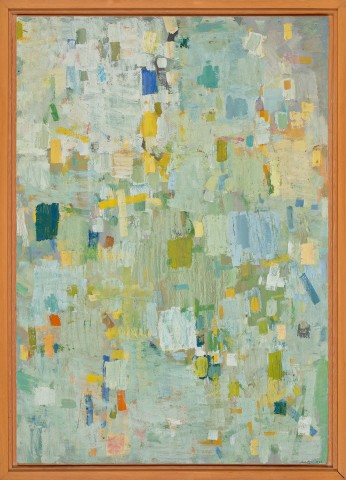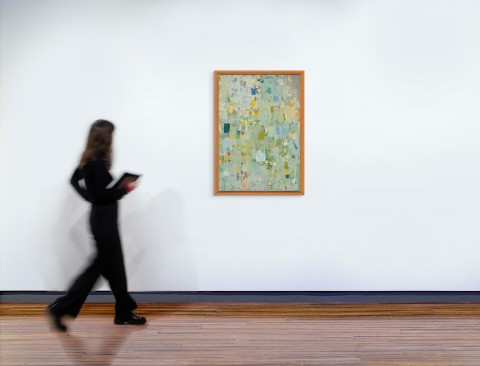CONSTRUCTION IN COLOUR, 1960
YVONNE AUDETTE
synthetic polymer paint on cardboard on composition board
100.5 x 70.0 cm
signed and dated lower right: Audette 1960
signed, dated and inscribed with title verso: Audette 1960 / 'Construction in Colour'
Mossgreen Gallery, Melbourne
Private collection, Sydney, acquired from the above in 2008
Sotheby's, Sydney, 3 May 2017, lot 66
John Barnes, Melbourne, acquired from the above
The Estate of John Barnes, Melbourne
Yvonne Audette: Different Directions 1954 – 1966, National Gallery of Victoria, Melbourne, 13 September 2007 – 17 February 2008 (label attached verso)
Yvonne Audette 1950s – 2008: A Selling Retrospective Exhibition, Mossgreen Gallery, Melbourne, 16 October – 5 November 2008, cat. 14 (illus. in exhibition catalogue)
Heathcote, C., Adams, B., Vaughan, G., and Grant, K., Yvonne Audette: Paintings and Drawings 1949 – 2003, Macmillan, Melbourne, 2003, pl. 63, pp. 106 (illus.), 247
In contrast to most of her peers, Australian artist Yvonne Audette spent her formative years in 1950s New York, absorbing the influences of avant-garde abstract expressionism before taking these and settling in Italy at the precocious age of 26. With a luminous springtime palette and emanating fragile warmth from beneath milky layers of paint, Construction in Colour, 1960 was painted there, between 1958 and 1960, in parallel with the artist’s more structured geometric and linear arrangements, which she named the Cantata series.1 Processing with confidence the aesthetic experiences of the American painters exhibiting at in the 1958 Venice Biennale and l’art informel of Paris the following year, Audette’s works became more atmospheric and lyrically focussed on subtle colour harmonies, although several retained the urban-inflected ‘construction’ title of her earliest oils. The diaphanous quality of Construction in Colour, interspersed with rhythmic squares of saturated hues, was surely informed by the artist’s initial delicate gouache-and-ink studies of tone, shape and movement.2
Although anchored by a woven lattice of cumulative blocky brushstrokes and shapes, the final composition of Construction in Colour is almost entirely devoid of clear linear marks. Audette has thinly painted over her work with waves of translucent white and pale green pigment, carefully building up and removing layers to reveal the luminous hues beneath and leave traces of raw gesture on the painting’s chalky surface. These are not, however, the gestures of a dramatic and spontaneous abstract expressionist – each brushstroke is considered and carefully placed, combined with supreme serenity. The arrangement of iterated strokes, hatchings, and scumbled squares jostle against each other with sometimes startling colour contrasts, layered in complex palimpsests that confuse a clear reading of the artist’s process. The artist described this technique as: ‘transparent glazes can send lines and colours back into space so that other lines and forms can come forward. Whitewashes over the existing marks and colours are often used to destroy, also scraping back and scratching at the work opens up new possibilities. This allows freedom for an accident to happen, as well as enabling mind and imagination expansion.’3
Audette’s lyrical abstract compositions reflected the multilayered histories she encountered in the ancient towns of Europe where she lived: ‘When I went to Europe in the mid-50s… my work responded to the layering of society itself – the remnants of murals on walls, the frescoes, the whole antiquity of the civilisation.’4 She had shared an interest in ancient haphazard marks left on Italian walls with American artist and neighbour, Cy Twombly – both artists then incorporating doodled and scratched surfaces into their abstract paintings. Audette’s mark-making, either repetitious and patterned or arranged with raucous randomness, contains a musical quality of harmony, fugue or discord. Construction in Colour, quiet and peaceful, is a harmonious painting of the highest artistic order, demonstrating Audette’s mature orchestration of opacity, gesture and subtle colour variation.
1. Heathcote, C. et al., Yvonne Audette: Paintings and Drawings 1949 – 2014, Macmillan Art Publishing, Melbourne, 2014, pp. 106 (illus.); 247
2. C.f. Study for Oil Painting, 1959, and Moving Squares, 1959, illustrated ibid., pl. 77 and 78, pp. 116 – 117
3. Yvonne Audette, cited in Yvonne Audette: Different Directions 1954 – 1966, National Gallery of Victoria, Melbourne, 2007, n. p.
4. Yvonne Audette, cited in McCulloch-Uehlin, S., ‘Abstraction’s Forgotten Generation’, The Australian, 23 April 1999, p. 9
LUCIE REEVES-SMITH


